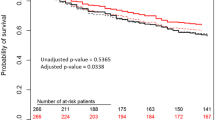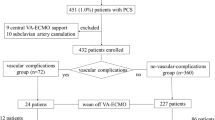Abstract
Subacute groin complications associated with extracorporeal membrane oxygenation (ECMO) cannulation are well recognized, yet their effects on clinical outcomes remain unknown. This single-center, retrospective study reviewed all patients receiving venoarterial ECMO from 01/2017 to 02/2020. Cohorts analyzed included transplanted patients (TPs) and non-transplanted patients (N-TPs) who did or did not develop ECMO-related subacute groin complications. Standard descriptive statistics were used for comparisons. Logistic regressions identified associated risk factors. Overall, 82/367 (22.3%) ECMO patients developed subacute groin complications, including 25/82 (30.5%) seromas/lymphoceles, 32/82 (39.0%) hematomas, 18/82 (22.0%) infections, and 7/82 (8.5%) non-specified collections. Of these, 20/82 (24.4%) underwent surgical interventions, most of which were muscle flaps (14/20, 70.0%). TPs had a higher incidence of subacute groin complications than N-TPs (14/28, 50.0% vs. 68/339, 20.1%, P = 0.001). Seromas/lymphoceles more often developed in TPs than N-TPs (10/14, 71.4% vs. 15/68, 22.1%, P = 0.001). Most patients with subacute groin complications survived to discharge (60/68, 88.2%). N-TPs who developed subacute groin complications had longer post-ECMO lengths of stay than those who did not (34 days, IQR 16–53 days vs. 17 days, IQR 8–34 days, P < 0.001). Post-ECMO length of stay was also longer among patients who underwent related surgical interventions compared to those who did not (50 days, IQR 35–67 days vs. 29 days, IQR 16–49 days, P = 0.007). Transplantation was the strongest risk factor for developing subacute groin complications (OR 3.91, CI95% 1.52–10.04, P = 0.005). Subacute groin complications and related surgical interventions are common after ECMO cannulation and are associated with longer hospital stays. When surgical management is warranted, muscle flaps may reduce lengths of stay compared to other surgical interventions.
Similar content being viewed by others
References
Cheng R, Hachamovitch R, Kittleson M, et al. Complications of extracorporeal membrane oxygenation for treatment of cardiogenic shock and cardiac arrest: a meta-analysis of 1866 adult patients. Ann Thorac Surg. 2014;97:610–6. https://doi.org/10.1016/j.athoracsur.2013.09.008.
Tanaka D, Hirose H, Cavarocchi N, Entwistle JW. The impact of vascular complications on survival of patients on venoarterial extracorporeal membrane oxygenation. Ann Thorac Surg. 2016;101:1729–34. https://doi.org/10.1016/j.athoracsur.2015.10.095.
Kagawa E, Inoue I, Kawagoe T, et al. Assessment of outcomes and differences between in- and out-of-hospital cardiac arrest patients treated with cardiopulmonary resuscitation using extracorporeal life support. Resuscitation. 2010;81:968–73. https://doi.org/10.1016/j.resuscitation.2010.03.037.
Salna M, Takayama H, Garan AR, et al. Incidence and risk factors of groin lymphocele formation after venoarterial extracorporeal membrane oxygenation in cardiogenic shock patients. J Vasc Surg. 2018;67:542–8. https://doi.org/10.1016/j.jvs.2017.05.127.
Allou N, Lo Pinto H, Persichini R, et al. Cannula-related infection in patients supported by peripheral ECMO: clinical and microbiological characteristics. ASAIO J. 2019;65:180–6. https://doi.org/10.1097/MAT.0000000000000771.
Keyser A, Philipp A, Zeman F, et al. Percutaneous cannulation for extracorporeal life support in severely and morbidly obese patients. J Intensive Care Med. 2020;35:919–26. https://doi.org/10.1177/0885066618801547.
Salna M, Chicotka S, Biscotti M 3rd, et al. Morbid obesity is not a contraindication to transport on extracorporeal support. Eur J Cardiothorac Surg. 2018;53:793–8. https://doi.org/10.1093/ejcts/ezx452.
Price A, Contractor U, White R, Williams I. The use of vascularised muscle flaps for treatment or prevention of wound complications following arterial surgery in the groin. Int Wound J. 2020;17:1669–77. https://doi.org/10.1111/iwj.13449.
Katsogridakis E, Pokusevski G, Perricone V. The role of sartorius muscle flaps in the management of complex groin wounds. Interact Cardiovasc Thorac Surg. 2019;28:635–7. https://doi.org/10.1093/icvts/ivy300.
Dua A, Rothenberg KA, Lavingia K, Ho VT, Rao C, Desai SS. Outcomes of gracilis muscle flaps in the management of groin complications after arterial bypass with prosthetic graft. Ann Vasc Surg. 2018;51:113–8. https://doi.org/10.1016/j.avsg.2018.02.009.
Shermak MA, Yee K, Wong L, Jones CE, Wong J. Surgical management of groin lymphatic complications after arterial bypass surgery. Plast Reconstr Surg. 2005;115:1954–62. https://doi.org/10.1097/01.prs.0000165069.15384.e5.
Acknowledgements
The authors have no funding to disclose or other acknowledgements.
Author information
Authors and Affiliations
Corresponding authors
Ethics declarations
Conflict of interest
The authors have no conflicts of interest.
Additional information
Publisher's Note
Springer Nature remains neutral with regard to jurisdictional claims in published maps and institutional affiliations.
Rights and permissions
About this article
Cite this article
Smood, B., Fowler, C., Rao, S.D. et al. Subacute groin complications related to ECMO cannulation are associated with longer hospitalizations. J Artif Organs 26, 119–126 (2023). https://doi.org/10.1007/s10047-022-01342-3
Received:
Accepted:
Published:
Issue Date:
DOI: https://doi.org/10.1007/s10047-022-01342-3




